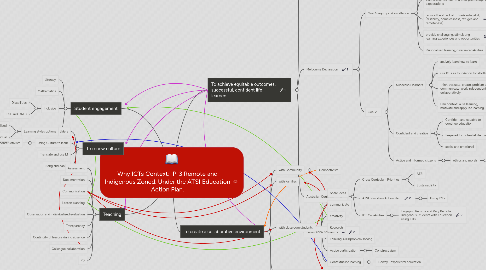
1. To renew culture
1.1. Learn from Elders
1.2. Using Culture to learn
1.2.1. social constructivism
1.3. Translate and use L1
1.4. Song and dance
2. Student engagement
2.1. Literacy
2.2. Mathematics
2.3. Inclusive
2.3.1. Disabilities
2.3.2. ESL and CALD
2.4. Learning styles options
2.4.1. Personalised
2.4.2. Individual
3. Teaching
3.1. Assessment
3.2. Documentation
3.3. Communication
3.4. Lesson planning
3.5. Observation and individualised evaluation
3.6. Transparency
3.7. Continuity of lessons during absence
3.8. Colleague collaboration
3.9. PD
4. To achieve equitable outcomes, successful, confident life learners.
4.1. United Nations
4.1.1. ICT in Education
4.1.2. Declaration on the Rights of Indigenous Peoples
4.1.2.1. Bronfenbrenner ecological sytems
4.2. Melbourne Declaration
4.2.1. Goal 1- equity and excellence
4.2.1.1. all students access to high-quality schooling free from discrimination (language, disability, poor socioeconomics, geographic location)
4.2.1.2. cultural knowledge as learning foundation in partnership with communities promoting high expectations
4.2.1.2.1. Vygotsky ZPD
4.2.1.3. reduce the effect of ...disadvantage(s), (disability, homelessness, refugee and remoteness)
4.2.1.4. provide challenging, stimulating learning experiences and opportunities
4.2.1.5. Personalised learning, diverse capabilities
4.2.1.5.1. Gardners Multiple Intelligences
4.2.2. Goal 2 -
4.2.2.1. Successful learners
4.2.2.1.1. actively learn how to learn
4.2.2.1.2. use ICTs as foundation for all other areas
4.2.2.1.3. think, evaluate, create, problem solve, communicate, work independently and collaboratively,
4.2.2.1.4. Can contextualise learning, motivate and apply life learning
4.2.2.2. Confident and creative
4.2.2.2.1. Confident and capable to continue education
4.2.2.2.2. Prepared for potential life roles
4.2.2.2.3. social and emotional
4.2.2.3. Active and informed citizens
4.2.2.3.1. ethics and morals
4.3. Australian Curriculum
4.3.1. Cross Curriculum Priorities
4.3.1.1. ATSI
4.3.1.2. Sustainablility
4.3.2. ATSI Education Action Plan
4.3.2.1. Using ICTs
4.3.3. ICT Capabilities
4.3.3.1. Engaging Remote and Very Remote Indigenous Students with Education using ICTs
4.4. Professional standards
5. To create a collaborative environment
5.1. with Community
5.1.1. Connectivism
5.2. with Families
5.3. with classroom students
5.3.1. Share ideas
5.3.2. communicate
5.3.3. creativity
5.3.4. Research
5.3.5. Thinking skills/problem solving
5.3.6. Active participation
5.3.6.1. Constructivism
5.3.7. Contextualise learning
5.3.7.1. Dewey - experiental education
